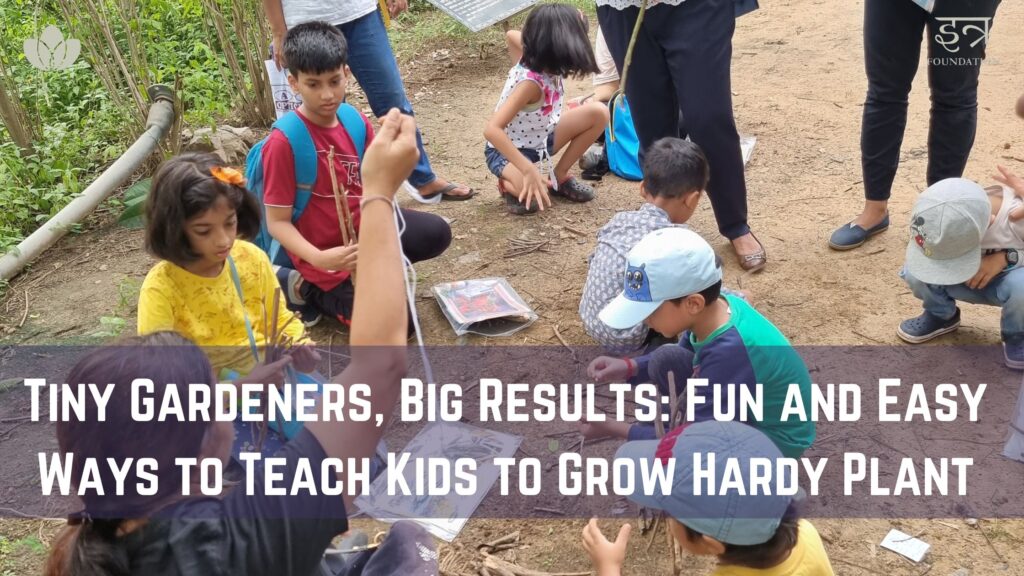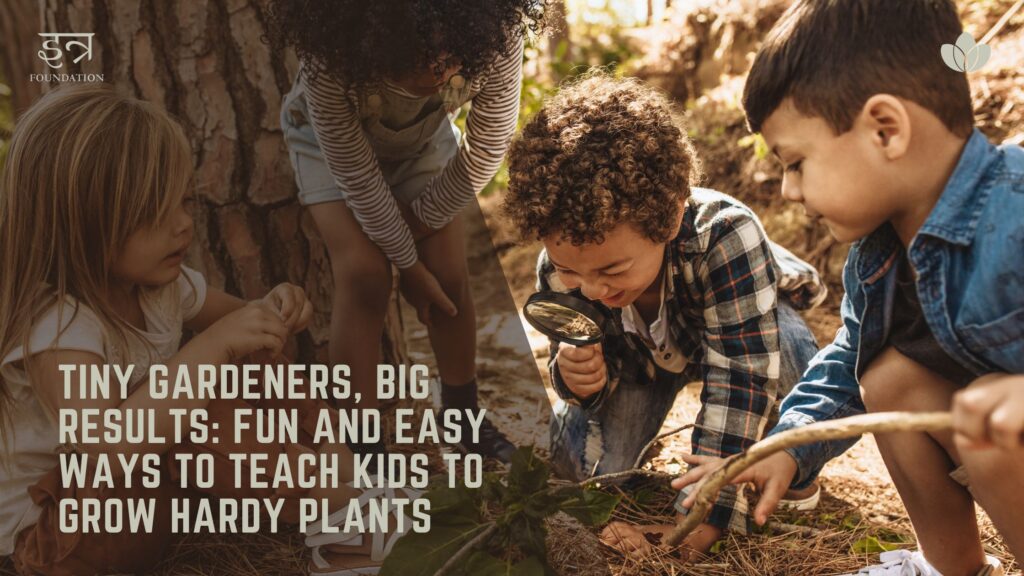As an environmental NGO, ITRA Foundation strongly believes in the power of connecting people, particularly kids, with the natural world. One of the best ways to do this is by teaching them to grow plants. Not only does this activity offer a multitude of benefits, both for the children and the environment, but it’s also a fun and engaging way to get them interested in the outdoors. In this blog post, we’ll explore three key areas related to teaching kids to grow hardy plants. First, we’ll discuss the many benefits of this activity, including improved physical health, mental wellbeing, and environmental stewardship. Second, we’ll explain why it’s crucial to choose hardy plants that are easy for kids to grow and care for, to ensure their success and foster their love of gardening. Finally, we’ll offer some fun and easy ways for parents, teachers, and caregivers to get kids started with growing their own hardy plants. At ITRA Foundation, we believe that introducing kids to the joys of gardening is one of the most effective ways to help them form a lifelong connection with nature. So join us on this journey, and let’s discover the wonders of growing hardy plants together!
Choosing the right plants for kids
We at ITRA Foundation know that choosing the right plants is crucial when introducing kids to the joys of gardening. We believe that hardy plants are the best choice for young gardeners, as they are easy to grow and care for, and can withstand a variety of conditions. When selecting plants for kids, it’s important to consider the following characteristics of hardy plants:
A) Characteristics of Hardy Plants:
They are adaptable to different soil and weather conditions.
They can withstand temperature fluctuations, pests, and diseases.
They are resilient and can recover quickly from damage.
They require minimal maintenance, making them easy for kids to care for.
B) Examples of Hardy Plants Suitable for Kids:
Hardy Plants Suitable for easy growing by Kids: jade, mother of thousand , snake plant,umbrella palm money plant and zz plant
Jade: Jade, also known as Crassula ovata, is a succulent plant that is easy to grow and care for. It has small, round leaves and a woody stem, and can thrive in a variety of light conditions. Jade plants are also known for their air-purifying qualities,
Mother of Thousands: Mother of Thousands, also known as Kalanchoe is a succulent plant that produces small plantlets on the edges of its leaves. These plantlets can be easily propagated by simply planting them in soil, making it a fun and easy plant for kids to grow.
Snake Plant: Snake plants, also known as Sansevieria, are known for their long, pointed leaves that grow upright from the soil. They are very hardy and can tolerate low light conditions and infrequent watering. Additionally, snake plants are known for their air-purifying qualities, making them a great choice for a child’s bedroom or play area.
Umbrella Palm: Umbrella palm is easy to care for and can tolerate a wide range of light and humidity conditions
Money Plant: Money plant, also known as Pothos, is a trailing vine with heart-shaped leaves that come in a variety of colors, from green to yellow to variegated. It is easy to care for and can thrive in low light conditions
ZZ Plant: ZZ plant, also known as Zamioculcas zamiifolia, is known for its glossy, dark green leaves and ability to tolerate low light and infrequent watering. It is very hardy and can thrive in a variety of conditions, making it a great choice for a child who may not have a green thumb yet.
C) Tips for Choosing Plants That Will Thrive in Your Area:
Consider the climate and weather conditions in your region.
Choose plants that are native to your area, as they are better adapted to the local environment.
Look for plants that are labeled as “drought-tolerant” or “low-maintenance,” as these are likely to be hardy varieties.
Consult with local garden centers or plant nurseries for expert advice on what plants will thrive in your specific area.
By choosing hardy plants that are suitable for your region, you can ensure that your young gardeners have a positive experience and develop a lifelong love of gardening. At ITRA Foundation, we believe that introducing kids to the wonders of growing their own plants is a powerful way to help them connect with nature and develop an appreciation for the environment.
Fun and easy ways to grow hardy plants:
We at itra foundation believe that growing hardy plants is a fun and rewarding activity for kids, and a great way to connect with nature. Here are three fun and easy ways to get started:
A) Starting Seeds Indoors:Materials Needed: Seeds, small containers or seed trays, soil, water, and a sunny windowsill or grow light.
Step-by-Step Instructions:
- Fill the containers with soil and moisten the soil with water.
- Plant one or two seeds in each container, according to the seed packet instructions.
- Cover the containers with plastic wrap or a clear lid to retain moisture.
- Place the containers on a sunny windowsil
- Keep the soil moist and watch the seeds grow!
- B) Planting Outdoors:
Preparing the Soil:
Choose a spot with well-draining soil and full sun. Remove any weeds or debris from the area and loosen the soil with a shovel or tiller.
Planting and Watering:
- Dig a hole for the plant that is slightly larger than the root ball.
- Place the plant in the hole and backfill with soil.
- Water the plant thoroughly and add a layer of mulch around the base to retain moisture.
- C) Making a Container Garden:
Choosing the Right Container: Choose a container that is deep enough for the roots of the plant and has drainage holes in the bottom. Consider using a recycled item such as an old bucket or wooden crate.
Planting and Maintaining a Container Garden:
- Fill the container with soil and moisten the soil with water.
- Plant one or two seeds or seedlings in the container, according to the seed packet instructions.
- Water the plants regularly and fertilize as needed.
- Move the container to a sunny spot as needed to ensure the plants get enough light.
Teaching kids about plant care
As an environmental NGO working to connect people with nature, one of our goals is to teach kids about plant care. By learning how to care for plants, kids can develop valuable skills like responsibility, patience, and problem-solving. They can also gain a deeper understanding of the natural world and the importance of conservation.
Watering and fertilizing are essential aspects of plant care. It’s important to teach kids how to water plants properly, including how much water to use and how often to water. Similarly, they should learn how to fertilize plants in a safe and effective way.
We should also teach them about the importance of using organic fertilizers and composting to improve soil health and reduce waste.
Monitoring for pests and diseases is another important aspect of plant care. Kids can learn to recognize signs of pest damage or disease, and how to take appropriate action to control the problem
It’s important to teach them about the dangers of using harmful chemicals and the benefits of using natural pest control methods.
Harvesting and using herbs and vegetables is a fun and rewarding way to teach kids about plant care. They can learn about the different parts of plants that are edible, how to harvest them properly, and how to prepare them for cooking or eating.
This can also help encourage healthy eating habits and reduce food waste.
Overall, teaching kids about plant care is an important step towards building a more sustainable future. By empowering them with knowledge and skills, we can help create a generation that is more connected to the environment and more capable of making positive change.
By using these fun and easy methods for growing hardy plants, kids can enjoy the process of gardening and learn valuable skills such as patience, responsibility, and environmental stewardship. At ITRA Foundation, we believe that connecting kids with nature through gardening is an important way to help them appreciate and care for the natural world.As an environmental NGO working to connect people with nature, I believe that teaching kids about growing hardy plants is an important step towards building a sustainable future. By fostering a love of nature and teaching kids valuable skills like responsibility and problem-solving, we can help create a generation that is more connected to the environment.
The rewards of growing hardy plants with kids are many. Not only do they get to experience the joy of watching their plants grow, but they also gain a deeper understanding of the natural world and the importance of conservation. Growing plants can also provide a sense of accomplishment and pride in taking care of something living.
Encouraging kids to continue learning about plants is crucial for their continued growth and development. Whether it’s through books, online resources, or gardening clubs, there are many ways to help kids explore their passion for plants. Encourage them to experiment with different types of plants and growing methods, and to share their knowledge with others.
Finally, here are some tips and resources for successful plant growing with kids:
Choose hardy plants that are easy to grow and maintain.
Use child-friendly tools and equipment, and provide adult supervision when necessary.
Involve kids in every step of the growing process, from planting to harvesting.
Encourage creativity and experimentation, and allow kids to make mistakes and learn from them.
Resources like gardening books, online forums, and community gardening programs can provide additional support and guidance.
Overall, teaching kids about growing hardy plants can be a fun and rewarding experience for everyone involved. By fostering a love of nature and empowering kids to take an active role in caring for the environment, we can help create a brighter, more sustainable future.




